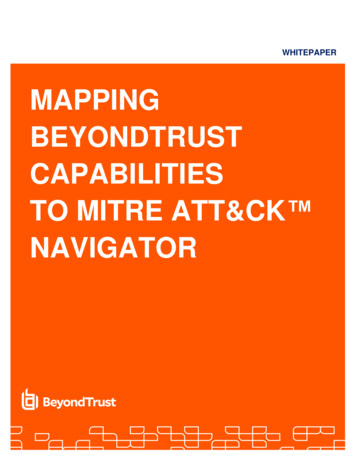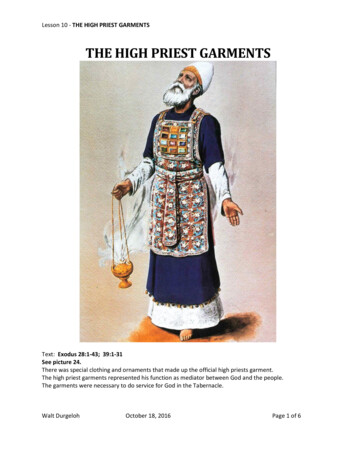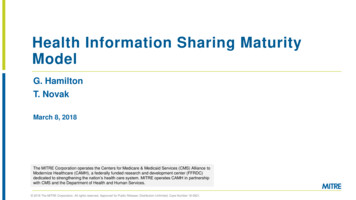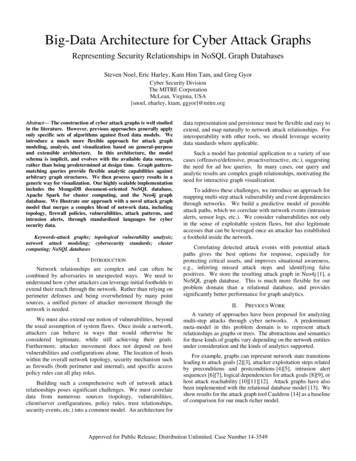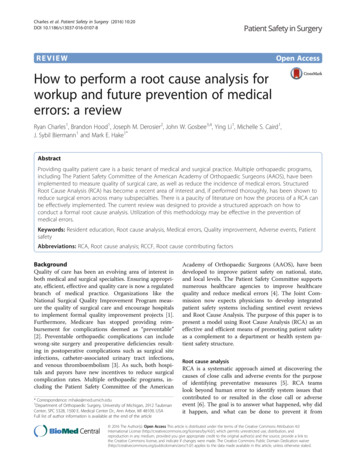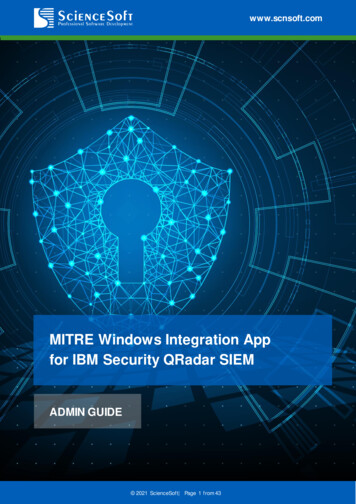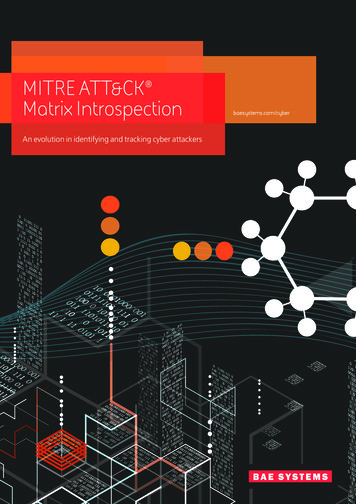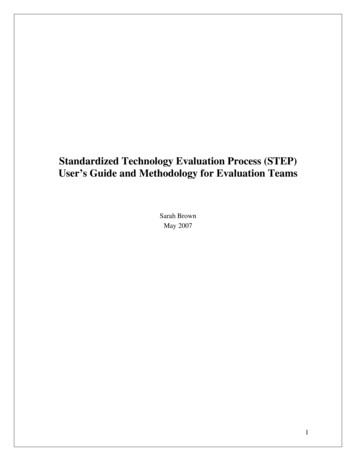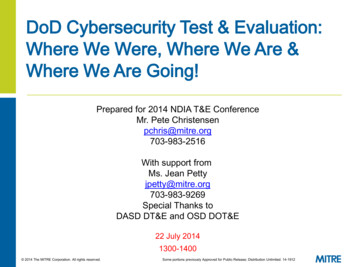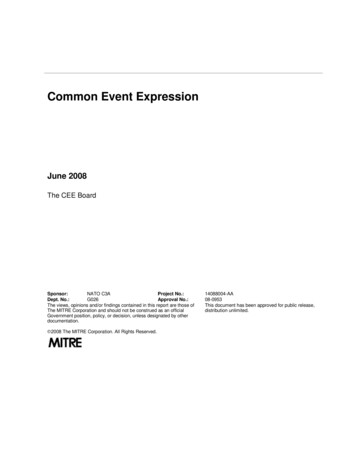
Transcription
Common Event ExpressionJune 2008The CEE BoardSponsor:NATO C3AProject No.:Dept. No.:G026Approval No.:The views, opinions and/or findings contained in this report are those ofThe MITRE Corporation and should not be construed as an officialGovernment position, policy, or decision, unless designated by otherdocumentation.2008 The MITRE Corporation. All Rights Reserved.14088004-AA08-0953This document has been approved for public release,distribution unlimited.
AbstractThis paper defines a framework to enable collaborative efforts in the creation of an open,practical, and industry-accepted event interoperability standard for electronic systems—Common Event Expression (CEE ). MITRE and industry, in collaboration with the NATOConsultation, Command, and Control Agency (NC3A), offer the CEE effort to standardizeIT event logs. While acknowledging the challenges in developing logging standards and thecontributions of past attempts, we describe a well-defined, bounded problem and provide acommon collection of terminology with which to frame the effort. We recommend aframework to address the various components of an electronic event standard: an openformat event expression taxonomy, log syntax, log transport, and log recommendations. Thiseffort goes beyond any previous attempts to standardize the event interoperability space inthat we begin by defining the event language and using it as motivation for the syntax andtransport, and then recommend what should be logged.i
AcknowledgmentsThe CEE Board acts as an advisory body to help define and provide strategic direction toCEE. This document results from the combined effort of the founding CEE members:MITRENon-MITREW. J. HeinbockelA. Chuvakin, LogLogicJ. T. JudgeR. Marty, SplunkR. M. McQuaidWe would like to thank Anton Chuvakin and Raffy Marty, who provided much of themotivation for the CEE effort, and have been very supportive. Their comments and criticismsare reflected throughout this whitepaper. Without their enthusiasm and their rallying of othersupport, CEE would be merely a passing thought.We would also like to acknowledge the members of the CEE Discussion mailing list for theirfeedback and insights, and for keeping us grounded amidst the confusion. Most notably, weappreciate the many comments from Stanford Whitehouse.iii
Table of Contents1Problem Description1-12Scope2-13Proposed CEE Framework3-13.1Common Event Taxonomy3-23.2Common Log Transport and Syntax3-33.3Log Recommendations3-4Event Interoperability Examples4-14.1Enterprise Event Management: Oil Pipeline Monitoring4-14.2Regulatory Compliance: Financial Solutions4-445Comparison to Prior Efforts5-16Why CEE?6-16.16.2Why Should We Attempt Yet Another Log Standard?What Distinguishes CEE?6-1How Could CEE Benefit Me or My Company?Why Should We Support CEE?6-1Appendix ABibliographyA-1Appendix BCEE RoadmapB-1Appendix CTerminologyC-1Appendix DAcronym ListD-1v
List of FiguresFigure 3-1. CEE Architecture . 3-1Figure 3-2. Examples Mapped to CEE Components . 3-2Figure 4-1. Example Network for Monitoring Oil Production . 4-2Figure 4-2. Correlating Correlation Engines . 4-3Figure 4-3. Flow of Event Information from Sensors to an Operator . 4-3vi
List of TablesTable 6-1. Motivations for Various Standard Stakeholders . 6-3
1 Problem DescriptionAll electronic systems can detect numerous distinct events—observable situations orenvironment changes—of which only a fraction are ever recorded, or logged. The actuallogging of an event can occur in many ways: by writing to a text log file, by transmitting thedata via Syslog or other network logging protocol, or by storing the data in proprietary binaryfiles or databases for later query.Logs contain information about events, which can include device states, monitor readings,and a variety of other information. Logs are often further characterized as data logs, auditlogs, alerts, alarms, audit trails, and a variety of similar terms.In an ideal situation, the logs generated by various devices would reflect a near-real-timeinfrastructure awareness; they should represent every event that affected a particular device.With all of the necessary event data available, information technology (IT) operations shouldbe able to aggregate, correlate, and prioritize the logs in order to detect any significantevents, including anomalous or malicious behaviors, and maintain a constant state of overallsystem awareness.Unfortunately, due to the disparate logging practices and log formats used by differentdevices and vendors, creating such an optimal environment requires an overwhelmingmanual effort. To make the log data usable, each heterogeneous log message must beindividually interpreted and normalized into a consistent representation. Only after the logshave been processed can the consumer begin to collect required regulatory data, applycustom rule sets, or perform any aggregation or correlation. Furthermore, any change in theoperational environment, including the deployment of new technologies or the updating ofexisting ones, requires operators to reexamine all the rules and log templates of thesupporting log management architecture. NIST Publication 800-92 [4] further details theseissues and states that the problem stems from ―inconsistent log formats,‖ noting that ―there isno consensus in the security community as to the standard terms to be used to describe thecomposition of log entries and files.‖1-1
2 ScopeCommon Event Expression (CEE ) is being developed to address the overall problem ofevent representation, communication, and interpretation. We propose that industry adoptCEE as the accepted way to describe and communicate events in log files.Several academic and commercial event standards have previously been proposed in thisarea, including Intrusion Detection Message Exchange Format (IDMEF) and WebTrendsEnhanced Log File (WELF). However, none of them has gained widespread usage orreached the point of being recognized as an industry standard because they only targeted aportion of the larger issue or were tied to individual vendors. As a solution, CEErecommends industry coordination in four different areas to facilitate log management andanalysis. The CEE components of Common Log Transport, Common Log Syntax, CommonEvent Expression Taxonomy, and the Common Event Log Recommendations provide aframework to achieve consensus in log transportation, log syntax, event representation, andevent logging recommendations for various log sources and scenarios.We note that CEE focuses on individual device-generated events, not on whole securityincidents. The term ―incident‖ refers to the collection of information regarding impact, time,cost, or confidence assessments; point-of-contact details; mitigation strategies; and anyinformation related to the human factors surrounding incidents and incident response.Incident-related efforts such as IODEF (Incident Object Description Exchange Format) aretherefore considered outside the scope of CEE. However, incident reports often include eventlogs, which may be provided in the CEE format, and a CEE-defined event may beincorporated into IODEF-defined incidents.2-1
3 Proposed CEE FrameworkAs a starting point for the development of CEE, we believe that the problem can be bestaddressed as a combination of recommendations related to four sub-elements: log transport,log syntax, expression taxonomy, and logging. Developers could work on these sub-elementsindependently. This section concentrates on the three CEE components necessary to enableevent exchange: the taxonomy, syntax, and transport. Once these components are defined,any CEE message can be received, parsed, and understood.The interaction of these three elements in the conversion from events to logs (Figure 3-1)begins with an event occurring, which is represented within the taxonomy. Then the syntax isfilled with the associated details, which are transported to a receiver. Once the receiver gets aCEE message via a specific transport, it parses all of the details from the syntax, and theevent is understood with the expressed taxonomy.Figure 3-1. CEE ArchitectureThe subtle distinctions between these components make it difficult for many people todistinguish the faint boundaries between them. Figure 3-2 illustrates how practical logcapabilities map into CEE. If a Simple Network Management Protocol (SNMP) Trap istranslated into our CEE elements, the transport is the SNMP protocol version over port162/UDP [User Datagram Protocol], the syntax is determined by the object identifier (OID)as encoded via ASN.1, and the event is identified, or expressed, as the ManagementInformation Base (MIB) and is further categorized as a specific entry in common eventtaxonomy. Similarly, when moving logs using a proprietary Simple Object Access Protocol(SOAP)-based protocol, the transport is HyperText Transport Protocol (HTTP), the syntax is3-1
defined by a specific eXtensible Markup Language (XML) schema, and the event expressionis defined in the form of a common taxonomy entry. However, the CEE developers prefer touse natural language whenever possible to enhance human readability.Figure 3-2. Examples Mapped to CEE Components3.1 Common Event TaxonomyThe Common Event Expression Taxonomy (CEET) represents the keystone of CEE. CEETis an event language—an unambiguous way of classifying logged events. If multiple systemsobserve the same event, their taxonomy description of that event should be identical.Therefore, a computer should be able to determine immediately whether two logs refer to thesame type of event. For this to happen, the system needs a collection of well-defined wordsthat can be combined in a predictable fashion. Presumably these words would describe thetype of activity, the actors involved, the outcome, and other relevant event data.What does this mean for end-users? For example, take the simple event of the root userlogging into a system. In the PAM framework, this event is expressed as ―sessionopened for user root by LOGIN(uid 0).‖ In a typical Linux distribution itmight be logged as ―ROOT LOGIN ON tty1,‖ while a Snort trigger reports ―POLICYROOT login attempt [Classification: Misc activity] [Priority:3].‖The goal of CEET is for each of these different products to identify the event using the sameterminology. Log interpretation would become far more straightforward if an event werealways reported in the same manner, with authentication events always represented bysimilar phrasing. By defining and utilizing a common taxonomy for recording events, CEET3-2
offers a scalable and universal way to convey the meaning of event messages to both humanand computer recipients. Event producers can be constrained to recording one event per logentry and supporting a model more focused on the event consumer. By eliminating thesubjective information sometimes seen in current log messages—such as perceived impact orimportance—CEET allows end-users and event consumers to generate a more flexible,accurate, environment-focused overview that takes into account all possible logs from allsupporting devices.CEET may follow one of several approaches. One way is to provide a vocabulary associatedwith categories or ―buckets‖ for various event characteristics. The buckets might be―subject,‖ ―object,‖ ―action type,‖ and so on. The event producer would select theappropriate term in each bucket. A similar approach would be to define a pseudo-languagewith subjects, objects, verbs, etc., along with a finite set of words. In this case, the producerwould build a parsable grammar out of the elements.3.2 Common Log Transport and SyntaxCEE makes a distinct separation between the transport and the log syntax. While the syntaxis unique, it can be expressed and transmitted in a number of different ways. For example,the syntax may be expressed in XML and transported via SOAP or e-mail (SMTP). Somesyntax and transport options are complementary, but others do not work as well, such ascommunicating XML over Syslog or SNMP. Whether the event syntax is recorded locally ina flat file (to be transported over FTP [File Transfer Protocol] or SCP [Secure Copy]protocols in batch mode) or sent via the network on a known protocol, this choice should beleft up to the event producers and consumers. Both the sender and receiver must agree on thecommunication channel to be used. The Common Log Transport (CLT) is used to define thepotential media.A key feature of the CEE standard effort is that many of the currently used log transportoptions may be adopted as supplemental ―standards.‖ For example, millions of Unix-derivedsystems use Syslog over port UDP 514, which thus can probably be ―blessed‖ as a standardlog transport mechanism.The Common Log Syntax (CLS) defines a dictionary of syntactic identifiers to be used forcommunicating details regarding a logged instance of an event. Since it is not possible tocreate a syntax that is appropriate for every situation, the dictionary must define a universalset of terms along with their data types and usage (e.g., source, destination, username,domain, etc. that may be reused for previous standard efforts). Using the same datadictionary assures event consumers and end-users that the expected event details are includedand used consistently.A syntax should provide options for different ways of transmitting information, dependingon the environment and objectives. An administrator should be able to choose the besttransport, regardless of whether it is an encoded binary syntax, name-value pairs, or an3-3
XML-based mechanism. The following three possibilities address speed, ease of use, andexpressiveness.Speed – A binary log format (and corresponding syntax of fixed-size fields in abinary file) can express comprehensive information and is the fastest way to log andexchange data. Compressed binary is the best option when the goal is to minimizesize and network impact. However, binary syntaxes are not designed for humanreadability and require conversion libraries for encoding and decoding logs.Ease-of-use – Plaintext syntaxes include delimited and key-value pairs, such as CSV[comma-separated value] and CEF [Common Event Format], that humans andmachines can more easily read and understand. With a fairly basic syntax, this formatis very practical and would most likely gain the greatest overall acceptance by eventproducers and consumers. Additionally, this type of syntax offers compatibility witha majority of transports. At the same time, this format is not as speed-efficient as thebinary format discussed above.Expressiveness – Syntaxes based on structures such as XML are comprehensive andcapable of representing complex data structures, such as lists and nested objectrelationships. Similar to ease-of-use syntax options, an XML-based syntax would bea desirable option for some event producers and consumers. Some drawbacks includea limited choice of compatible transports, extra space for storage and transmissionrequired by the overhead, and possible difficulties with human understanding of suchlogs. Since most event data is fairly straightforward, forcing it into an expressivesyntax would be unnecessary.3.3 Log RecommendationsCommon Event Log Recommendations (CELR) provide logging guidance for the CEEinitiative. With a common way of expressing events, it is possible to stipulate what eventsproducts should log. While it should be expected that a firewall should log events such asblocked connection attempts, there are no formal logging advisements. Should firewalls logall rule change events? Should they log login and administration events? CELR will ensurethat administrators receive a comprehensive view of all auditable events.CELR addresses not only what events to log, but also what information to capture, such aslevel of detail. This translates to ―What are the various event representation elements andhow should they be fulfilled?‖ Returning to the firewall example, the system should beguided by recommendations as to what data should be included with various firewall-relatedevents: for instance, source, destination, NAT’ed [Network Address Translation] sources,ports, protocols, and the connection result (allowed, dropped, etc.). Further considerationsinclude how applications should log certain events—username, source, connection method,and results for authentication; configuration changes; and a plethora of other important eventinformation. Similarly, intrusion detection systems (IDS) and intrusion prevention systems3-4
would benefit from guidance concerning how to report potential attack events, such as thesource, destination, what triggered the alert, and any known attack to which the alert isrelated.One important outcome of CELR regarding network sensors would be a standardestablishing whether sensors should report what they detected, interpretations of what theydetected, or both. For higher level or automated analysis, the packet details are facts andgenerally more useful for correlation and analysis. However, an alert that suggests a bufferoverflow attack or brute-force login attempts based upon signatures may be better for asmall-scale local area network (LAN) and add some input value to prioritizing. Thisinformation can then be used as feedback to improve the CEE syntax and expressiontaxonomy.3-5
4 Event Interoperability ExamplesAs further motivation for event standardization, we provide several atypical examples of theways in which CEE will benefit industry, from vendors to consumers. The first model,described in Section 4.1, illustrates how an event standard helps correlate and manage eventsacross an enterprise. In Section 4.2, we use a hypothetical financial corporation to show howa company can leverage CEE to assist with regulatory standards compliance. These exampleswere designed to demonstrate the increased capability that results from standardizing logs,while still maintaining an obvious correlation with the IT network in an organization.4.1 Enterprise Event Management: Oil Pipeline MonitoringIn oil companies, as in most enterprise environments, logs are monitored on a network. In thiscase, the network is responsible for operations of an oil pipeline (Figure 5-1). Sensors installedto monitor various points along the oil pipeline report back data, such as the oil purity,throughput, pressure, and temperature. However, the various types of electronic devices usedto audit the pipeline’s health and status transmit information in a variety of disparate logformats.Meanwhile, a correlation engine receives the logs from those sensors, as well as other devicesincluding IDS, proxy servers, anti-virus scans, and firewalls. With the supporting loginfrastructure, any operator should easily be able to identify any problems in the oil flow or thesupporting network. For example, if both the pipeline and network security sensors logsuspicious data, an operator should be able to detect in near-real time if an external attackerpenetrates a firewall, gains access to an internal system, and causes the temperature monitor toreport anomalous data, which in turn causes the pipeline to react by stopping the oil flow.However, when the devices logging these events use different transports, syntaxes,structures, and content, machine interpretation and correlation cannot occur. Correlationengines are limited; they can only correlate across a bounded number of devices that are―known‖ to the engine. Support by a correlation engine becomes a manual process ofinterpreting and understanding every log template. Thus, an expert human analyst is neededto make sense of the events and to tie these records together into a coherent incident ―story.‖This lack of event interoperability is becoming an intractable problem as the number ofelectronic systems and their generated events increase — an obstacle that can be bestaddressed by an accepted, industry-wide event expression standard. By adopting a unifiedlanguage for expressing content of logs, any correlation engine can immediately support thelogs from any device and thus automate analysis of the incident, eliminating the mostexpensive, unscalable, and often error-prone link from this chain: the human analyst.4-1
Figure 4-1. Example Network for Monitoring Oil ProductionBy standardizing the input and output log syntax and language, CEE would eliminate thecontinual maintenance associated with regular expression parsing and correlation engineupdates. Given the same set of logs, the resulting correlation engine report should containsimilar information and use the same syntax and the same unified language. With theseengines using the same output formats for similar reports, correlation could now occur atmore abstract levels, resulting in summary views of current situational awareness (Figure 42). Various correlation engines could be deployed across the corporation in a hierarchicalstructure to feed reports upward to a master correlation engine. Continuing with the oilpipeline network example, several satellite offices set up along the length of the pipelinecould have their own support infrastructure, while allowing headquarters to maintainoversight of the entire operation. If similar or causal failures occur, or a coordinated attacktakes place on multiple points along the pipeline, an operator at the dashboard of the mastercorrelation engine could immediately detect and troubleshoot it.Figure 4-3 portrays a more abstract flow of information from sensors deployed throughout anenterprise to an operator. Logs can express events at different abstraction levels and containinformation valuable to everyone from the operator to the chief executive officer. Supportingsuch an impressive array of consumers requires standardization of the transport, syntax, andexpression taxonomy of event log communication.4-2
Figure 4-2. Correlating Correlation EnginesFigure 4-3. Flow of Event Information from Sensors to an Operator4-3
4.2 Regulatory Compliance: Financial SolutionsWhile few industries must maintain an oil pipeline, many must comply with variousregulatory standards. PCI DSS [Payment Card Industry Data Security Standard], SOX[Sarbanes-Oxley] and GLBA [Gramm-Leach-Bliley Act], HIPAA [Health InsurancePortability and Accountability Act], FISMA [Federal Information Security ManagementAct], COBIT [Control Objectives for Information and Related Technology], ITIL[Information Technology Infrastructure Library], ISO27001 [International StandardsOrganization], and the EUDPD [European Union Data Protection Directive] and Basel II inEurope, are acronyms with which most businesses are all too familiar. The requirements setforth carry heavy fines for non-compliance. In the end, they force companies to spendmillions of dollars to meet and maintain a satisfactory record.In no industry is this truer than in finance. Banks, stockbrokerages, investment agencies, andother financially integrated professions are required to audit each transaction while ensuringcompliance with multiple regulatory standards. Even though the monetary transactions andcompliance needs overlap, these aspects are handled by different systems. IT and systemevents can affect financial systems, posing a risk to the industry. Since companies mustindividually monitor and bring into compliance hundreds of internal supporting applications,log management appliances and custom applications have become a necessity. Without anyaudit and event standards in place, monitoring and compliance become a larger and moreexpensive burden.To comply with current regulatory standards, each organization is required to audit variousevents, such as those concerning user activity or information accesses. To get thisinformation, the industry must be certain that its systems are correctly logging the requiredevent types and that those logs are being retained. At this point, each organization faces theproblems resulting from the lack of a log standard—every device records the same eventtypes in a different manner. Even though the company knows exactly what event types andcorresponding information should be audited, there is no way to correlate each actual eventlog with its event type. Without a standard, it costs time and money to perform a manualreview of the logs generated by each device. Organization-wide awareness, workflowmonitoring, and compliance regulations could be streamlined and become less burdensomewhen all events are logged according to the same standard.4-4
5 Comparison to Prior EffortsThere have been several previous attempts to develop event and log interoperabilitystandards. For one reason or another, these efforts have failed to gain industry support: somewere too academic, while others were too narrowly focused. Some of the more notableefforts are highlighted below.CBE – The Common Base Event [2] model, led by IBM, is a standard that defines anXML event syntax. CBE is described as a ―common language to detect, log andresolve system problems‖ [10] and is supported by several Tivoli products with thegoal of achieving autonomic computing. Since the public release of the specificationand IBM’s partnering with Cisco in 2003 CBE has continued to be activelymaintained, but has yet to have any noticeable industry impact, even across IBM’sown product lines.CEF – The newest foray (September 2006) into event syntax standards is the CommonEvent Format [1] from ArcSight. A CEF message is composed of delimited plaintextstrings with optional sets of key-value pairs. It is relatively simple to generate andparse, and is transport independent. CEF is the preferred communication method ofArcSight products, such as the Enterprise Security Manager (ESM), and is supportedby several other products.CIDF – The Common Intrusion Detection Framework, which defined the CommonIntrusion Specification Language (CISL), was sponsored by the Defense AdvancedResearch Projects Agency (DARPA) [3]. CISL was proposed in 1999 and usedEnglish-like sentence expressions and syntax trees in order to represent intrusionevents. The CIDF effort was later merged in with IDMEF.IDMEF – The Intrusion Detection Message Exchange Format is an Internet EngineeringTask Force (IETF) effort that followed CIDF. IDMEF [6] was designed to enable thecommunication of intrusion events observed by IDS devices. It consists of twoentities: a syntax expressed in XML and the transport protocol (Intrusion DetectionExchange Protocol – IDXP). First proposed in 2002, with the most recent updateoccurring in 2004, IDMEF is supported by a very limited number of intrusiondetection products. It also suffers from a narrow focus on intrusion events, and thus isunsuitable for logging audits and system troubleshooting.SDEE – Security Device Event Exchange [7] was developed by the ICSA Labs and theIntrusion Detection Systems Consortium (IDSC). The SDEE XML syntax is built onthe SOAP transport and appears to be supported only by Cisco. Since SDEE’sintroduction in 2003, little has been done to update and support this effort.WELF – The WebTrends Enhanced Log file Format [8] is similar to CEF in that it is notbound to any specific transport and represents log data using plaintext, key-valuepairs. WELF consists of four required and twenty optional syntax fields limited to5-1
expressing firewall, virtual private network (VPN), and other simple network-basedevents.XDAS - Distributed Audit Service [9] is a prior Open Group effort that has beenreinvigorated with the help of Novell. The XDAS specification is quite large and isintended to solve the log exchange problem by defining logging applicationprogramming interfaces (APIs). While the use of a common programming librarywith a listing of log events is a step in the right direction, there will never be a ―onesize fits all‖ programmatic solution: the standard should drive the software libraries,not vice versa. Aside from the support of Novell, it is unlikely that XDAS will see itsAPI in any major codebase.Update: The XDAS working group has released a 2.0 specification available on theirwebsite.IODEF, discussed previously, is included in the interest of completeness and because it iscommonly and incorrectly categorized as an event standard:IODEF – The Incident Object Description Exchange Format [5] was developed by theIETF to improve computer incident response communications and is often associatedwith IDMEF. Since CEE and IODEF focus on different areas, they should be viewedas complements and not replacements for one another. IODEF centers on the humanto-human communication of incident response, not on how the incident wasdiscovered or on the formatting of related log files. While CEE messages should beincluded in IODEF reports, IODEF falls outside the scope of CEE.5-2
6 Why CEE?6.1 Why Should We Attempt Yet Another Log Standard?What Distinguishes CEE?Every other effort involving event and log standardization has either too closely coupled thesyntax and transport components, thus limiting usability, or has developed its standard tosupport a single, narrowly defined use-case. CEE attempts to standardize the heterogeneousvocabulary so that events can be expressed in a uniform, device-independent manner.The developers realize that a single syntax is not suitable for every environment. CEE offersvendors and operators the flexibility to choose the best option by providing several flexiblesyntax and transport options, including—which is very important!—currently utilizedtransport and format options, which the CEE standard effort will adopt.6.2 How Could CEE Benefit Me or My Compan
W. J. Heinbockel A. Chuvakin, LogLogic J. T. Judge R. Marty, Splunk R. M. McQuaid We would like to thank Anton Chuvakin and Raffy Marty, who provided much of the motivation for the CEE effort, and have been very supportive. Their comments and criticisms are reflected throughout this whitepaper.
